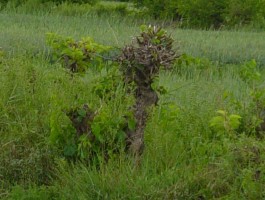Sericulture (growing silk worms) has been practised for 4500 years and today Uzbekistan is the third largest producer of silk in the world (after China and India). Each spring the collective farms are given a quota of newly hatched worms that are around 2-3mm in length. Each household receives a batch of worms, which they grow in their own living rooms to keep them warm and protected from predators. At first the worms are fairly easy to look after. They don't eat much and can only eat freshly chopped up mulberry leaves. However they will grow from 2-3mm to up to 12cm in length within their five week cycle, becoming ten thousand times heavier!
The silkworms rapidly grow in size and a batch that filled up one living room now fills up at least two sheds as well. Keeping the worms indoors helps increase humidity and keeps the leaves from drying out.
The worms can now eat whole mulberry leaves straight from the branch. After each skin moult the worm's jaw becomes stronger. The sound of worms munching is like rice krispies with milk; they really are eating machines!
Keeping the worms well fed is not an easy task, with villagers working from before sun rise until after sunset, feeding the worms five times a day. In Spring you can see villagers all over Khorezm cutting down mulberry branches to feed their worms.
Mulberry trees grown for sericulture are distinctively shaped with thick trunks and long thin branches that are cut back each year to provide the worms with food. Unlike the beautiful old mulberry trees surrounding Labi Hauz in Bukhara, these trees will only live for around seventy years due to aggressive pruning.
The worms quickly decimate each branch of mulberry leaves. However, around six days after their last skin moult the worms stop eating and spend a week resting as their bodies began to prepare for their weaving task ahead. Meanwhile, the exhausted villagers drag themselves out to the desert to collect dry desert bushes which make ideal spinning sites for the worms. The bushes are placed on top of the trestle tables of worms and the worms select a good site for spinning their cocoons and begin, working from the outside in.
The cocoons vary in shape and size. A cold spring produces longer, thinner cocoons whilst a hot spring produces shorter, fatter ones. The shape doesn't effect the quality of the silk though. A healthy, well fed worm can produce a cocoon that can unravel as long as 1 km.
The moths emerge from the cocoons after around two weeks, however, before this happens, the vast majority of pupas are killed using hot air or steam. A few are allowed to hatch out (destroying the cocoon in the process) to produce eggs for next year.
The cocoons are placed in hot water in order to unravel them. According to legend, the Yellow Empress of China was enjoying a quiet cup of green tea in her garden when a silk cocoon plopped into her cup from the overhanging mulberry tree. As she attempted to fish it out, it began to unravel and the secret of silk was discovered. The unravelled silk fibre is hooked onto a spindle and around eight to ten cocoons bob up and down as they unravel and are spun together to make one thread.








 Coming to Khiva? Visit the interactive guidebook to the sights and culture of Khiva.
Coming to Khiva? Visit the interactive guidebook to the sights and culture of Khiva.